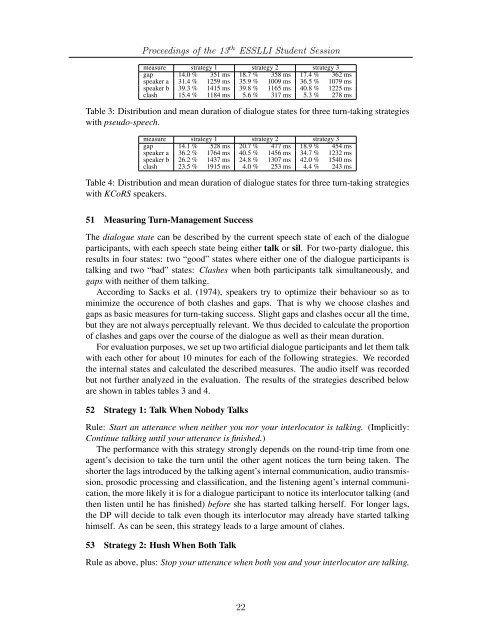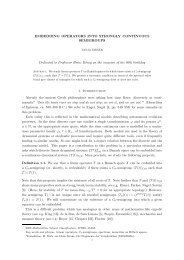Proceedings of the 13 ESSLLI Student Session - Multiple Choices ...
Proceedings of the 13 ESSLLI Student Session - Multiple Choices ...
Proceedings of the 13 ESSLLI Student Session - Multiple Choices ...
Create successful ePaper yourself
Turn your PDF publications into a flip-book with our unique Google optimized e-Paper software.
<strong>Proceedings</strong> <strong>of</strong> <strong>the</strong> <strong>13</strong> th <strong>ESSLLI</strong> <strong>Student</strong> <strong>Session</strong><br />
measure strategy 1 strategy 2 strategy 3<br />
gap 14.0 % 351 ms 18.7 % 358 ms 17.4 % 362 ms<br />
speaker a 31.4 % 1259 ms 35.9 % 1009 ms 36.5 % 1079 ms<br />
speaker b 39.3 % 1415 ms 39.8 % 1165 ms 40.8 % 1225 ms<br />
clash 15.4 % 1184 ms 5.6 % 317 ms 5.3 % 278 ms<br />
Table 3: Distribution and mean duration <strong>of</strong> dialogue states for three turn-taking strategies<br />
with pseudo-speech.<br />
measure strategy 1 strategy 2 strategy 3<br />
gap 14.1 % 528 ms 20.7 % 477 ms 18.9 % 454 ms<br />
speaker a 36.2 % 1764 ms 40.5 % 1456 ms 34.7 % 1232 ms<br />
speaker b 26.2 % 1437 ms 24.8 % <strong>13</strong>07 ms 42.0 % 1540 ms<br />
clash 23.5 % 1915 ms 4.0 % 253 ms 4.4 % 243 ms<br />
Table 4: Distribution and mean duration <strong>of</strong> dialogue states for three turn-taking strategies<br />
with KCoRS speakers.<br />
51 Measuring Turn-Management Success<br />
The dialogue state can be described by <strong>the</strong> current speech state <strong>of</strong> each <strong>of</strong> <strong>the</strong> dialogue<br />
participants, with each speech state being ei<strong>the</strong>r talk or sil. For two-party dialogue, this<br />
results in four states: two “good” states where ei<strong>the</strong>r one <strong>of</strong> <strong>the</strong> dialogue participants is<br />
talking and two “bad” states: Clashes when both participants talk simultaneously, and<br />
gaps with nei<strong>the</strong>r <strong>of</strong> <strong>the</strong>m talking.<br />
According to Sacks et al. (1974), speakers try to optimize <strong>the</strong>ir behaviour so as to<br />
minimize <strong>the</strong> occurence <strong>of</strong> both clashes and gaps. That is why we choose clashes and<br />
gaps as basic measures for turn-taking success. Slight gaps and clashes occur all <strong>the</strong> time,<br />
but <strong>the</strong>y are not always perceptually relevant. We thus decided to calculate <strong>the</strong> proportion<br />
<strong>of</strong> clashes and gaps over <strong>the</strong> course <strong>of</strong> <strong>the</strong> dialogue as well as <strong>the</strong>ir mean duration.<br />
For evaluation purposes, we set up two artificial dialogue participants and let <strong>the</strong>m talk<br />
with each o<strong>the</strong>r for about 10 minutes for each <strong>of</strong> <strong>the</strong> following strategies. We recorded<br />
<strong>the</strong> internal states and calculated <strong>the</strong> described measures. The audio itself was recorded<br />
but not fur<strong>the</strong>r analyzed in <strong>the</strong> evaluation. The results <strong>of</strong> <strong>the</strong> strategies described below<br />
are shown in tables tables 3 and 4.<br />
52 Strategy 1: Talk When Nobody Talks<br />
Rule: Start an utterance when nei<strong>the</strong>r you nor your interlocutor is talking. (Implicitly:<br />
Continue talking until your utterance is finished.)<br />
The performance with this strategy strongly depends on <strong>the</strong> round-trip time from one<br />
agent’s decision to take <strong>the</strong> turn until <strong>the</strong> o<strong>the</strong>r agent notices <strong>the</strong> turn being taken. The<br />
shorter <strong>the</strong> lags introduced by <strong>the</strong> talking agent’s internal communication, audio transmission,<br />
prosodic processing and classification, and <strong>the</strong> listening agent’s internal communication,<br />
<strong>the</strong> more likely it is for a dialogue participant to notice its interlocutor talking (and<br />
<strong>the</strong>n listen until he has finished) before she has started talking herself. For longer lags,<br />
<strong>the</strong> DP will decide to talk even though its interlocutor may already have started talking<br />
himself. As can be seen, this strategy leads to a large amount <strong>of</strong> clahes.<br />
53 Strategy 2: Hush When Both Talk<br />
Rule as above, plus: Stop your utterance when both you and your interlocutor are talking.<br />
22

















